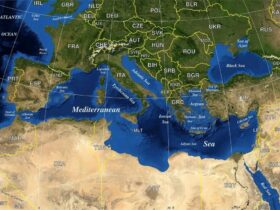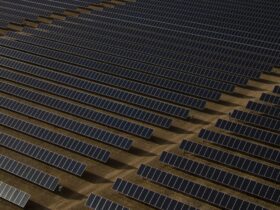Saudi Arabia has been almost entirely dependent on the revenue earned from oil exports since oil was first discovered in the country in 1938 in Dammam. This allowed the industrialization and social and economic development of the nation into one almost entirely reliant on petroleum exports.
Saudi Arabia currently controls 17% of proven global petroleum reserves. It is classified as an oil-dependent economy because as of 2022 it earns 80% of its export income through oil and more than 40% of its GDP depends on petroleum exports, making it the third-most oil-reliant country in the world after Kuwait and Libya. These numbers are down from a decade ago, when in 2012 over 90% of export income and 45% of GDP depended on oil. Clearly, Saudi Arabia’s attempts to diversify its economy have made some progress, with forays into industries such as transportation and entertainment.
The Russian invasion of Ukraine and resulting Western sanctions on Russian oil has skyrocketed demand for oil globally, causing oil prices to increase. However, this will not be the case forever. Oil is simply not a viable option any longer for Saudi Arabia’s future. It is estimated that at the current rates of extraction, Saudi oil reserves will be completely depleted in 60 years. Oil revenues are also expected to decline significantly by 2040 because of decreases in global demand.
Other high-oil countries (HOCs) in the Middle East — such as Bahrain, Qatar, and the UAE — have faced the similar dilemma of finding a sustainable solution to the survival of their nations built on the export of an unsustainable resource. For example, Qatar — an economy built on oil and natural gas — has attempted to increase its global influence by investing in infrastructure attractive enough to draw foreign interest, such as Education City in Doha, which has branches of prestigious Western universities such as Georgetown and Cornell, or the hosting of the 2022 World Cup.
Saudi Vision 2030 is an initiative conceptualized and led by Saudi Crown Prince Mohammed bin Salman to distance the Saudi economy from its reliance on oil — and by extent, dependence on foreign trading partners — and diversify the economy. Bin Salman is attempting to lead the country into the future and away from what he termed “a case of oil addiction.” The initiative was introduced in April 2016, with components such as the establishment of an e-government system, the creation of a Saudi tourism industry and allowing women to drive.
The creation of this project was spurred by the steep decrease in crude oil prices in the summer of 2014, resulting in a state budget deficit of almost $100 billion in 2015, with the Vision released the following year.
Saudi Arabia, like most HOCs in the Middle East, is a rentier state, with a significant portion of its income relying on revenues from the sale of oil to outside sources. The primary goal of the Vision was to reduce Saudi economic dependency on foreign entities.
The Saudi Vision 2030 is built around three themes: a vibrant society, a thriving economy and an ambitious nation. One component of the Vision is the National Transformation Plan (NTP), which was implemented from 2016-2020 and aimed to boost non-oil revenue to $141 billion. The plan was successful, creating almost half a million non-government jobs, transforming 24 government agencies such as the Ministry of Investment to increase efficiency and ease of foreign participation, as well as furthering bin Salman’s drive toward the secularization of the Saudi government. At the end of 2022, Saudi Arabia reported its first budget surplus in almost a decade, thanks in large part to the results of this plan.
Another component of the Vision that has gained widespread attention and apprehension is NEOM, a planned smart city with a budget of $500 billion to be built in northern Saudi Arabia’s Takbuk province, on the coast of the Gulf of Aqaba. NEOM stands for New Future, combining the Greek word neos, meaning new, and the Arabic word mustaqbal, meaning future.
The smart city has faced skepticism over its feasibility, but if successful would diversify the Saudi economy through tourism, similar to the restructuring of tourism industries in Gulf countries such as Qatar and the UAE.
Part of NEOM, The Line, began construction in October of 2022. The Line is a futuristic sustainable city that is planned to revolutionize urban living by running on 100% renewable energy. It will accommodate 9 million residents within 34 square kilometers, which is unheard of compared to other cities of a similar capacity. The initiative’s focus on sustainability is driven by the desire to base the Saudi economy on ventures that — unlike the oil that has built Saudi Arabia — are not finite, investing in Saudi Arabia’s long-term future while appealing to foreign investment in their economy.
Part of the vibrant economy pillar of the Vision is a $2 trillion transformation fund aiming to reduce unemployment, increase female participation in the workforce, boost the role of the private sector in GDP, increase the localization of oil and gas sectors and increase foreign direct investment from 3.8% of GDP to the international level of 5.7%..
The Vision is not the first of its kind in the region, with projects such as UAE Vision 2021 and Abu Dhabi Vision 2030 which share similar objectives of social reform through economic diversification.
In the case of UAE Vision 2021, the objective of transforming the federation of states economically, politically, and socially to become “among the best countries in the world” was successfully completed over the decade since it launched. Saudi Vision 2030 mimics the methods used by the UAE of attracting foreign investors and integrating itself into the global tourism industry, expanding the international appeal of what is portrayed to be the technologically advanced ultra-wealthy utopia of the UAE.
The oil boom in the Middle East really began after the end of WWII, when HOCs in the region began producing oil on a large scale and resulting in immense revenues flowing into economically underdeveloped nations. Although it would be reasonably assumed that these economic inflows from high oil demand would lead to rapid growth, these countries were not equipped to ensure they benefited most effectively from the oil wealth.
Oil-dependent economies in the Middle East began to develop symptoms of the “resource curse,” which is a paradoxical situation where a country possesses an abundance of valuable natural resources but underperforms in terms of economic development. One clear example of this is Saudi Arabia, where the Saudi royal family is the richest in the world with an estimated $1.4 trillion in oil wealth, while 20% of the country’s population lives in poverty.
Because the oil in Saudi Arabia and many other Middle Eastern HOCs is under private ownership, usually by the monarch and their family, there has been little to no oversight of the management of oil revenues or requirements for their use in public endeavors.
However, revenues from oil were used somewhat throughout the Gulf countries for domestic development, and throughout the 1950s and 1960s the societies of countries such as the UAE and Qatar were completely transformed. The effect oil has had on the Middle East cannot be understated. Life expectancy increased in Saudi Arabia from 40 in 1950 to 75 in 2022. Transportation and sewer systems were built, quality of life improved astronomically and infrastructure projects have continued over the decades.
Through the Vision’s economic reforms, Saudi Arabia has already enacted “sin taxes,” with a 100% excise tax on energy drinks and tobacco, and a 15% value-added tax on almost all goods and services. This is in addition to taxing the private sector and landowners, and removing subsidies and stipends, although currently personal income is not taxed for Saudi citizens. Before the Vision, the government had never directly taxed its citizens, but the goal of these reforms is to increase reliance on domestic revenue to finance Saudi Arabia instead of external funding.
When a nation’s government utilizes taxation, this comes with the expectation of the country’s citizens of social pillars, such as infrastructure and government representation. When a state does not have to tax its citizens for financial support, this frees the government from any perceived social responsibility, creating a lack of accountability.
However, now that taxation has been implemented within Saudi Arabia in ways that affect its citizens, it would have been expected that the Saudis would protest for greater political participation. There was a trend on Twitter in 2020 shortly after further tax increases of posting pictures of the late King Abdullah, the former monarch who passed away in January of 2015, who was well-known for his concern for the poor. However, thus far, King Salman and the Crown Prince have managed any objections to the taxation by increasing social freedoms while also increasing repression.
This taxation is occurring as the nation is moving away from providing the plethora of public services previously funded by oil revenues. Citizens are paying the government more money for less social infrastructure, reaping fewer of the government-subsidized benefits they had enjoyed for the last 50 years.
As more of Saudi Arabia’s wealth is generated domestically as a result of the Vision, Saudi Arabia’s susceptibility to the whims and ulterior motives of foreign governments may decrease as the nation becomes more reliant on apolitical private sector foreign direct investment in the future.
Over the six years that the Vision has been enacted there has been measurable social and economic success: the share of women in the labor market has increased to 37% from 17% in 2016, tourism increased by 4 billion visitors between 2017 and 2019, and foreign direct investment increased from $1.42 billion in 2017 to $5.4 billion in 2020.
The Vision’s approach to ensure Saudi Arabia’s survival is having profound impacts on Saudi society and domestic governance. If successful, it could provide a model for other oil-dependent countries attempting to find their way into a future without the very resource that built their economies, ushering in an era of unprecedented political and social independence from the influence of foreign powers in the Gulf and profoundly transforming the political makeup of these societies.







